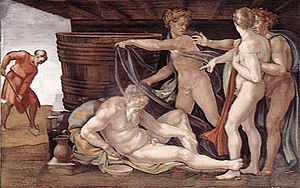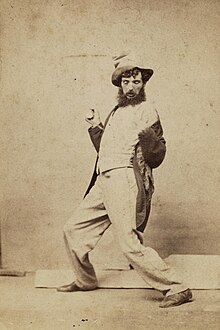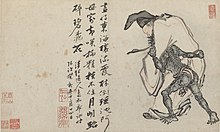酒精中毒
| 酒精中毒 | |
|---|---|
| 同义词 | 醉酒、急性酒精中毒、乙醇中毒[1][2] |
 | |
| 米开朗基罗1509年作品“酩酊大醉的诺亚” | |
| 症状 | 轻度: 轻度镇静状态, 肢体协调能力降低[3] 适度: 言语不清、步态障碍、呕吐[3] 严重: 换气不足(呼吸抑制),昏迷[3] |
| 并发症 | 癫痫发作、吸入性肺炎、伤害、低血糖[3][4] |
| 常见始发于 | 几分钟到几小时[5] |
| 病程 | 几个小时[5] |
| 肇因 | 乙醇(酒精)[6] |
| 风险因子 | 社会环境、冲动行为、酗酒[5][7] |
| 诊断方法 | 通常透过了解事件史和身体检查[6] |
| 相似疾病或共病 | 肝性脑病、韦尼克脑病、甲醇中毒、脑膜炎、创伤性脑损伤[6] |
| 治疗 | 对症治疗[6] |
| 盛行率 | 甚为通常(尤其在西方世界)[8] |
| 死亡数 | 在美国,每年约2,200人[9] |
| 分类和外部资源 | |
| 医学专科 | 毒理学,精神医学 |
| ICD-11 | 6C40.3 |
| ICD-10 | F10.0、T51 |
| MedlinePlus | 002644 |
| eMedicine | 812411 |
酒精中毒(英语:Alcohol intoxication),也可写为alcohol poisoning,[1]通常用来描述醉酒或是酩酊的状态,[10] 是因为新近饮酒而产生负面行为,以及对饮者身体造成的影响。[6][11]除酒精(乙醇)的毒性(主要精神活性成分)之外,还有酒精的代谢物 - 乙醛的活性所引起的生理症状。[12]影响可能要摄入数小时后才会出现,并会导致俗称的宿醉发生。
低剂量中毒症状可能包括轻度镇静状态和肢体协调笨拙。[3]在较高剂量的时候,可能会出现言语不清、共济失调和呕吐。[3]极高剂量会导致换气不足、昏迷、或是死亡。[3]相关的并发症可能包括癫痫发作、吸入性肺炎、伤害(包括自杀)、和低血糖。[3][4]酒精中毒会导致与酒精相关犯罪发生,而通常是肇事者比受害者的醉酒程度更高。[13]
酒精中毒通常在喝两杯或以上的酒后开始作用。[5]风险因素是喜好饮酒的社会风气,还有具有冲动个性的人。[5]对于酒精中毒的诊断通常透过了解事件历史和身体检查来达成。[6]有证人协助核实事件经过可能会有帮助。[6]就法律而言,酒精中毒通常被定义为血液酒精浓度(BAC)大于5.4–17.4毫摩尔/升(等于25–80毫克/分升,或是血液酒精含量到达0.025–0.080%)。[14][15]可通过血液或呼气测试作测量。[5]酒精在人体内以每小时约3.3毫摩尔/升(15毫克/分升)的速度分解,[6]依个人的代谢率而定(请参考代谢)。 [16]
酒精中毒的管理牵涉到对症治疗。[6]包括把患者置于复原卧式、保暖、并确保呼吸顺畅。[4]洗胃和运用活性炭两种方式被发现用处不大。[6]建议在治疗之前最好再做评估,以确定症状发生的真正原因。[6]
历史上有关急性酒精中毒的记录非常多,酒精一直是世上最普遍使用的娱乐性用药之一。[17][18]某些宗教认为酒精中毒是种罪恶。[5][19]
症状[编辑]

酒精中毒是由于新近饮用酒精而对健康造成的负面影响。[6]当情况严重时,它会成为医疗紧急情况。酒精中毒的某些影响,例如产生欣快感和降低社交抑制,成为酒精的重要吸引力。[20]
不同酒精摄取量的影响[编辑]
| 血液酒精浓度(BAC)(%含量) | 国际单位制(毫摩尔/升) | 毫克/分升 | 行为 | 损害 |
|---|---|---|---|---|
| 0.001–0.029 | 0.22–6.3 | 1–29 |
|
|
| 0.030–0.059 | 6.5–12.8 | 30-59 |
| |
| 0.060–0.099 | 13.0–21.5 | 60-99 | ||
| 0.100–0.199 | 21.7–43.3 | 100-199 | ||
| 0.200–0.299 | 43.4–64.9 | 200–299 | ||
| 0.300–0.399 | 65.1–86.6 | 300–399 | ||
| 0.400–0.500 | 86.80–108.5 | 400–500 |
| |
| >0.50 | >108.5 | >500 |
|
病理生理学[编辑]

正常肝脏以每小时约可代谢8公克纯乙醇。8公克(10毫升,或0.34美国液体盎司)被当作一份英国酒精标准单位。罹患有肝炎、肝硬化、胆囊疾病、和癌症等疾病的“异常”肝脏,代谢酒精的速度会降低。[22]
乙醇透过醇脱氢酶(ADH)代谢为乙醛,许多人体组织,包括胃粘膜,均存有这种酶。乙醛透过乙醛脱氢酶(ALDH)(主要存在肝线粒体中)代谢为乙酸。肌肉细胞使用乙酰辅酶A合成酶把乙酸转换成乙酰辅酶A,然后乙酰辅酶被用于柠檬酸循环。(柠檬酸循环是三大营养素-糖类、脂类及胺基酸的异化作用通路,又是同化作用的枢纽,此外,柠檬酸循环的中间产物可以提供细胞作为合成糖类、脂类、胺基酸等物质的前驱物。)[23][24]
随著饮酒量增加,人们会变得嗜睡或麻木。在喝下非常高的数量后,呼吸系统受到抑制,饮者将停止呼吸。昏迷的患者可能会吸入呕吐物(进入肺部,导致窒息,如果幸免于难,可能会成为吸入性肺炎)。中枢神经系统抑制和运动协调受损,加上判断力变差,会增加意外伤害的可能性。据估计,大约三分之一与酒精有关的死亡是由事故所造成,另外14%的死亡是由故意伤害而造成。[25]
除对中枢神经系统抑制导致呼吸衰竭和事故之外,酒精还会导致严重的代谢紊乱。低血糖是由于乙醇抑制糖异生(非碳水化合物转变为葡萄糖的过程),特别是发生在在儿童身上,会引起乳酸性酸中毒、酮症酸中毒、和急性肾损伤。呼吸衰竭加重代谢性酸中毒。患者也可能出现失温症。
机制[编辑]
请参考乙醇 (药物)英文版#Pharmacology部分
人们在过去认为酒精是一种影响大脑中许多神经递质系统的非特异性药物。[26]然而,分子药理学研究显示,酒精只会针对几个系统作用。在某些系统中,影响属于促进性,而在其他系统中则是抑制性的。
具有促进功能的神经递质系统包括:GABAA受体,[27]5-HT3受体激动剂[28](负责γ-氨基丁酸(GABAA受体变构调节剂)、甘氨酸能剂、和胆碱能药作用)、烟碱型乙酰胆碱受体。[29] 受到抑制的有:N-甲基-D-天冬氨酸(NMDA)、[28]L型钙通道α1亚基[30]和G蛋白门控离子通道。[31]
酒精也被磷脂酶D2转化为脂质代谢物磷脂酰乙醇,而且显示这种代谢物直接结合并调节离子通道。[32][33]这些直接影响的结果是一波进一步的间接影响,涉及各种其他神经递质和神经肽系统,最终导致酒精中毒行为或症状影响的形成。[26]
按照流传的说法如“只喝葡萄酒,或是谷物酒,不要混著喝”,还有“先喝啤酒,再喝葡萄酒,感觉愉快。先喝葡萄酒,再喝啤酒,感觉奇怪”,但有关依照顺序喝不同酒类的说法,醉酒的结果依然相同。[34]
GABAA受体[编辑]

许多激活GABAA受体物质的作用,与饮酒激活的结果相同。例如发生抗焦虑、抗痉挛、镇静、和安眠的作用,以及认知障碍和行动不协调的结果。[35]激活GABAA受体与饮酒产生的影响之间的相关性,导致针对乙醇及其对GABAA受体影响的研究。也发现乙醇对GABAA受体确实表现出积极别构调节的特质。然而,它的作用仅限于含有G蛋白δ-亚基,而不是含有γ-亚基的五聚体。[36]含有δ-亚基的GABAA受体已被证明位于突触外部,参与强直抑制,而其γ-亚基对应物仅参与阶段性抑制。[35]δ-亚基已被证明能够形成变构调节位点,使得含有δ-亚基的GABAA受体对乙醇浓度更敏感,甚至在中等社交乙醇饮酒水准(30毫莫耳每升)时也会作用。[37] 虽然提出研究报告的Sandeep Kumar等作者已证明含有δ-亚基的GABAA受体对乙醇调节敏感,但不同的亚基组合,受体敏感度会有变化。[38]而含有δ和β3亚基的GABAA受体会增加对乙醇的敏感性。[36]含有α3-β6-δ亚基的GABAA受体则对乙醇不敏感。[38]研究结果还显示亚基组合并非导致乙醇敏感性的唯一因素。GABAA受体分布在突触内的位置也会影响对乙醇的敏感性。[35]
诊断[编辑]
国际疾病与相关健康问题统计分类(ICD第10版)把酒精中毒描述为一种精神疾患和异常行为。[39]确定性的诊断要靠毒理学筛检来检测血液中的酒精含量。美国和其他国家的执法人员经常使用呼气式酒精检测仪和现场清醒度测试作为较方便和快捷的替代方法。[40]市面另有多种呼气式检测仪可供消费者使用。这些仪器可能具有不同的可靠性,并且可能会与执法目的的测试有不同的结果,对于此类设备提供的结果要审慎解读。
另有多种非正式的酒精中毒测试,但通常均非可靠,不推荐作为劝阻过度饮酒或是当作如机动车辆驾驶、重型设备和机床操作的安全指标使用。
除利用血液酒精测试以确定某人是否因饮酒而导致酒精中毒,也要使用其他方法,把其他情况,例如低血糖、中风、使用其他麻醉物、心理健康问题等排除。最好在受试者清醒时观察他们的行为以建立基线。可使用几种通用的标准来确定诊断。对于紧急治疗环境中的医生来说,急性酒精中毒与其他急性神经系统疾病相似,或者患者经常与娱乐性用药混合使用,会把诊断和治疗的复杂度增加。
处治[编辑]
急性酒精中毒有因呼吸抑制,或是因把呕吐物吸入导致吸入性肺炎而导致死亡的风险,属于紧急医疗情况。紧急治疗力求在等待酒精代谢的过程中,让患者的呼吸道维持通畅,呼吸顺利。这可透过排除呕吐物来完成,如果患者失去知觉或咽反射受损,则要进行气管插管。[41] 其他措施也包括
- 处理低血糖问题,因为乙醇引起的低血糖对胰高血糖素无反应,利用静脉注射糖溶液解决。
- 施用维生素B1以预防可能导致癫痫发作的韦尼克-科尔萨科夫症候群(这种做法通常用于治疗长期酗酒者,但也会在急性情况使用,以确保取得最高效果)。
- 如果酒精血液浓度非常高(高于130毫摩尔/升,或是600毫克/分升),则进行血液透析。[42]
- 根据需要,利用鼻插管或非循环呼吸面罩提供氧气治疗。
- 虽然药物美他多辛可能会加速酒精分解,但用于治疗酒精中毒需待进一步研究。截至2017年[6][43]这种药物在欧洲几国,以及印度和巴西已获批准使用。[43]
- 对于重度中毒特别是消化道症状明显的病人,可考虑施用胃黏膜保护剂,如质子泵抑制剂等。[44]
可能需用到其他药物来治疗恶心、震颤、和焦虑。
临床发现[编辑]
入院治疗[编辑]
在一项1999年到2004年所做的研究,美国年龄在18到24岁的群组因为创伤而接受治疗的人[8][45]中被发现普遍有酒精中毒的现象[46]。美国在2010至2012年间,年龄在15岁或以上的样本组中,平均每年有2,221人直接因为急性酒精中毒而死亡。[9]而每年有超过30,000人的死亡是间接由相同路径所造成。[5]
预后[编辑]
正常的肝脏会在一段时间内把血液中的酒精分解,取决于最初摄取的数量和患者的身体状况。只要酒精不达到让肝衰竭的程度,功能不全的肝脏仍能花较长的时间把酒精分解完毕。[47]
连续重度饮酒数天或数周的人,在急性酒精中毒消退后可能会出现酒精戒断症候群 症状。[48]
一个人持续摄入危险数量的酒精会导致酒精性失忆和特异性酒精中毒(或称病理性酒精中毒)症状发生。[49]
长期持续过量饮酒会导致肝损伤,并产生有害的健康结果。
社会与文化[编辑]

酒精中毒是导致某些重大伤害案例发生的危险因子,尤其是从事无人监督的休闲活动时候。加拿大安大略省根据1986、1989、1992、1995年的流行病学数据所做的研究显示,记录中的2,154起重大伤害中有79.2%是可预防的,而其中346起(17%)和饮酒有关联[50]。那些与酒精相关的重大伤害中。最常见是雪上摩托车(124)、捕鱼(41)、潜水(40)、划船(31) 和轻艇活动(7)、游泳(31)、驾驶全地形车(24 )、和骑自行车(23)。[50]这些事件通常发生在无人监管的年轻男性身上,他们往往缺乏经验,许多会导致溺毙的结果。[50]饮酒也与不安全的性行为有关联。
法律问题[编辑]

关于醉酒的法律问题在各地并不相同。在美国,酒后驾驶机动车辆是犯罪行为(威斯康辛州除外,初犯者仅会被处以罚款)。[51]酒后驾驶飞机,或在美国的某些州,酒后在游乐园从事游乐也属刑事犯罪。[52]英国和大多数其他国家也有类似的法律。
在一些国家,提供酒精给已经醉酒的人也是一种违法行为,[53]并且通常只有通过酒类服务训练的人员才能出售酒精。
符合驾驶车辆的血液酒精浓度(BAC),在罗马尼亚和阿拉伯联合大公国为0.00%;在澳大利亚、南非、德国、苏格兰、和纽西兰为0.05%(未成年人为0.00%);在英格兰和威尔士、美国、和加拿大为0.08%。[54]
美国联邦航空管理局禁止空勤人员在饮用酒精饮料后八小时内,仍可能受到酒精的影响下,或是BAC仍高于0.04%时登机服务。[55][56]
在美国、英国、和澳大利亚,公共场所醉酒被当作是种犯罪行为。[57]
有些国家设有专门的设施(有人称为“醉鬼拘留所”),用于暂时拘留那些醉酒者。
宗教对饮酒的观点[编辑]

一些宗教团体允许饮酒。有些允许,但禁止喝到醉的程度,而有些则完全禁止。许多基督教教派,如天主教会、正教会、和路德宗,都把葡萄酒作为圣餐礼的一部分,允许饮酒,但认为醉酒属于有罪。[58]
在旧约圣经的箴言中有几章谈及醉酒的坏影响,并警告人们远离会让人醉酒的饮料。利未记记载摩西的兄长亚伦的两位长子拿答和亚比户,可能在圣殿服务时因醉酒缘故而被杀。利末记继续讨论修道主义,这种修行禁酒。士师记中有关参孙的故事叙述有位但支派的僧侣,受到禁止剪头发和喝酒的约束。[59]新约圣经中的罗马书第13章第13和14节[60]哥林多前书第6章第9-11节、加拉太书第5章第19-21节、[61]和以弗所书第5章第18节[62]都载有反对醉酒的段落。箴言第31章第4节警告君王和统治者不要饮用葡萄酒和烈酒,箴言第31章第6-7节倡导给临终者喝烈酒,给生活苦涩的人喝葡萄酒,让他们把贫穷和苦难遗忘。[63]
某些基督新教教派因为圣经载有谴责醉酒的段落而禁止饮酒[59][64]但其他教派则允许适度饮酒。[65]在一些基督教团体中,饮用少量的葡萄酒是圣餐礼仪式的一部分。
耶稣基督后期圣徒教会教派则禁止饮酒,[66]遵守禁酒是这个教派成员的显著特征。耶和华见证人教派允许成员适度饮酒。
古兰经[67][68][69]禁止饮用以葡萄为原料的酒精饮料,圣训把醉酒认为可憎。麦兹海布(伊斯兰教法学中一个支派)的解读是严禁饮用所有类型的酒精,并称这种行为为哈拉姆 (“禁止的”、“违反教律的”)。
一般来说,佛教僧侣和普通信徒都不鼓励饮酒。许多佛教信徒都遵守五戒的行为准则,其中第五戒是承诺不饮酒[70](除非作医疗用途)。[71]在大乘佛教梵网经的愿中,同样不鼓励分送酒类,也不鼓励摄取。[72]
印度教中的高迪亚毗湿奴派支派,四项监管规矩之一就是禁止摄取麻醉物品(包括酒精)。
犹太教根据圣经,采反对饮酒的立场,[59]教士和修士都不许饮酒。[73]犹太圣经把安息日和其他犹太节日圣化,被理解为需要准备三顿礼仪餐,其中包括饮用葡萄酒,称之为Kiddush(字面意思是“成圣”,是对葡萄酒或葡萄汁的一种祝福)。[74][75]犹太婚礼以新娘和新郎在诵读七项祝福(请参考Sheva Brachot)后共享一杯葡萄酒结束,根据“阿什肯纳兹犹太人”的传统,在禁食一天之后也会饮用葡萄酒。但根据犹太教惯例,人们被要求适度饮酒以保持清醒,并且喝酒时机只在祈祷结束后方可。[76]
在逾越节晚餐时,参与者必须背诵哈加达(Haggadah)的同时,喝4杯礼仪酒。这种做法被认为是一些基督教团体圣餐饮酒仪式的源头。[77]根据普珥节的规定,人们被要求喝醉以示庆祝,在许多犹太社区会根据教令,利用白天睡觉来替代醉酒的行为。[78] 1920年代的犹太教改革派运动中,一位拉比提议在仪式上使用葡萄汁代替葡萄酒。虽在起初遭到驳斥,但这种做法后来被犹太教正统派广泛接受。[79]
在巴勒斯坦西岸希伯伦的麦比拉洞(犹太教中仅次于圣殿山,排名第二的圣地。穆斯林信徒称之为“易卜拉欣清真寺”),犹太人在婚礼、安息日、和犹太节日在此地的饮酒仪式,会与同样居住在此地的穆斯林之间产生紧张关系.[80]
其他动物的醉酒行为[编辑]
1974年金球奖最佳纪录片得奖作品《美丽的动物》中,展示许多不同的动物,包括猴子、大象、野猪、长颈鹿、和鸵鸟,吃了马鲁拉树过熟的果实,导致它们表现如同人类喝醉酒一般的摇晃和站立不稳的模样。[81]鸟类可能会因吃下发酵的浆果而发生醉酒情事,有些鸟类会因此撞上坚硬物体而死亡。[82][83]
发生在公元前167年到160年的马加比起义,还有发生在公元前第三世纪的第二次布匿战争,都曾使用过大象作战,根据记载,在攻击发动之前会提供酒类让大象饮用,受酒精影响的大象在象伕催促下冲锋向前。[84]
在爱尔兰,通常会提供少量啤酒给赛马饮用。反刍动物的胃中本来就会自然发酵,一般而言,提供少量的酒精饮料给予这类动物饮用不会对它们造成伤害,也不会导致它们醉酒。
酒精饮料对于狗类极为有害,[85]通常是因为饮料中添加人造甜味剂木糖醇的缘故。狗类除了在食物,或是饮料中吸收乙醇之外,也可透过皮肤吸收达到产生危险程度的乙醇。甚至是发酵的面团对狗而言也很危险。[86]
参见[编辑]
参考文献[编辑]
- ^ 1.0 1.1 Garfunkel, Lynn C.; Kaczorowski, Jeffrey; Christy, Cynthia. Pediatric Clinical Advisor E-Book: Instant Diagnosis and Treatment. Elsevier Health Sciences. 2007: 13 [2021-09-07]. ISBN 9780323070584. (原始内容存档于2021-12-22) (英语).
- ^ Gupta, P. K. Fundamentals of Toxicology: Essential Concepts and Applications. Academic Press. 2016 [2021-09-07]. ISBN 978-0-12-805403-1. (原始内容存档于2021-12-22) (英语).
Alcohol poisoning presents in two forms, acute and chronic. However, these are most often referred to as alcohol intoxication and alcohol addiction respectively.
- ^ 3.0 3.1 3.2 3.3 3.4 3.5 3.6 3.7 Alcohol Toxicity and Withdrawal. Merck Manuals Professional Edition. [24 May 2018]. (原始内容存档于2019-10-22).
- ^ 4.0 4.1 4.2 Alcohol poisoning. nhs.uk. 2017-10-17 [24 May 2018]. (原始内容存档于2017-10-11).
- ^ 5.0 5.1 5.2 5.3 5.4 5.5 5.6 5.7 American Psychiatric Association, Diagnostic and Statistical Manual of Mental Disorders (5th ed.), Arlington: American Psychiatric Publishing: 497–499, 2013, ISBN 978-0890425558
- ^ 6.00 6.01 6.02 6.03 6.04 6.05 6.06 6.07 6.08 6.09 6.10 6.11 6.12 Jung, YC; Namkoong, K. Alcohol: intoxication and poisoning – diagnosis and treatment. 125. 2014: 115–21. ISBN 9780444626196. PMID 25307571. doi:10.1016/B978-0-444-62619-6.00007-0.
|journal=被忽略 (帮助) - ^ Alcohol use disorder – Symptoms and causes. Mayo Clinic. [26 November 2019]. (原始内容存档于2019-10-08) (英语).
- ^ 8.0 8.1 Vonghia, L; Leggio, L; Ferrulli, A; Bertini, M; Gasbarrini, G; Addolorato, G; Alcoholism Treatment Study, Group. Acute alcohol intoxication.. European Journal of Internal Medicine. December 2008, 19 (8): 561–7. PMID 19046719. doi:10.1016/j.ejim.2007.06.033.
- ^ 9.0 9.1 Kanny, D; Brewer, RD; Mesnick, JB; Paulozzi, LJ; Naimi, TS; Lu, H. Vital signs: alcohol poisoning deaths – United States, 2010–2012.. MMWR. Morbidity and Mortality Weekly Report. 9 January 2015, 63 (53): 1238–42. PMC 4646044
 . PMID 25577989.
. PMID 25577989.
- ^ Meaning of inebriation in English. dictionary.cambridge.org Cambridge University Press. [24 June 2021]. (原始内容存档于24 June 2021).
- ^ Acute intoxication. WHO. [24 May 2018]. (原始内容存档于July 4, 2004).
- ^ Zakhari S. (2006) Overview: how is alcohol metabolized by the body?. (页面存档备份,存于互联网档案馆) Alcohol Res Health. 29 PMID 17718403 PMCID: PMC6527027, cite 4 in, Rusyn, Ivan; Bataller, Ramon. Alcohol and toxicity. Journal of Hepatology the Home of Liver Research (www.journal-of-hepatology.eu). 2013, 59 (2): 387–3881 August 2013 [24 June 2021]. PMC 3959903
 . PMID 23391479. doi:10.1016/j.jhep.2013.01.035. (原始内容存档于2021-12-22) –通过Microsoft Bing - Google Scholar.
. PMID 23391479. doi:10.1016/j.jhep.2013.01.035. (原始内容存档于2021-12-22) –通过Microsoft Bing - Google Scholar.
- ^ Sung, Hung-En, The Blackwell Encyclopedia of Sociology, American Cancer Society: 1–2, 2016, ISBN 978-1-4051-6551-8, doi:10.1002/9781405165518.wbeosa039.pub2 (英语)
|chapter=被忽略 (帮助) - ^ Ethanol Level: Reference Range, Interpretation, Collection and Panels. Medscape. 22 April 2018 [24 May 2018]. (原始内容存档于2020-01-21).
- ^ Canfield, DV; Dubowski, KM; Cowan, M; Harding, PM. Alcohol Limits and Public Safety.. Forensic Science Review. January 2014, 26 (1): 9–22. PMID 26226968.
- ^ Alcohol Alert. pubs.niaaa.nih.gov. [24 June 2021]. (原始内容存档于2021-02-28).
- ^ Belenko, Steven; Spohn, Cassia. Drugs, Crime, and Justice. SAGE Publications. 2014: PT21 [2021-09-07]. ISBN 9781483355429. (原始内容存档于2021-12-07).
- ^ Martin, Scott C. The SAGE Encyclopedia of Alcohol: Social, Cultural, and Historical Perspectives. SAGE Publications. 2014: PT1382 [2021-09-07]. ISBN 9781483374383. (原始内容存档于2021-12-22).
- ^ Kolig, Erich. Conservative Islam: A Cultural Anthropology. Lexington Books. 2012: 101 [2021-09-07]. ISBN 9780739174258. (原始内容存档于2022-04-26).
- ^ Dudley, Robert, 1961–. The drunken monkey : why we drink and abuse alcohol. Berkeley. May 2014. ISBN 978-0-520-95817-3. OCLC 869457130.
- ^ A hybridizing of effects as described at Alcohol's Effects 互联网档案馆的存档,存档日期May 5, 2007,. from Virginia Tech and Federal Aviation Regulation (CFR) 91.17: Alcohol and Flying (页面存档备份,存于互联网档案馆) (hosted on FlightPhysical.com)
- ^ How long does alcohol stay in your blood?. NHS Choices. 2018-06-26 [2021-09-07]. (原始内容存档于2017-12-31).
- ^ Smith, C., Marks, Allan D., Lieberman, Michael, 2005, Marks' Basic Medical Biochemistry: A Clinical Approach, 2nd ed., Lippincott Williams & Wilkins, USA, p. 458
- ^ 檸檬酸循環. 科学 Online. 5 May 2014 [14 August 2021]. (原始内容存档于2021-12-22).
- ^ The World Health Organization (2007) Alcohol and Injury in Emergency Departments
- ^ 26.0 26.1 Vengeliene, V; Bilbao, A; Molander, A; Spanagel, R. Neuropharmacology of alcohol addiction. British Journal of Pharmacology. 2008, 154 (2): 299–315. PMC 2442440
 . PMID 18311194. doi:10.1038/bjp.2008.30.
. PMID 18311194. doi:10.1038/bjp.2008.30.
- ^ Mihic, S. John; Ye, Qing; Wick, Marilee J.; Koltchine, Vladimir V.; Krasowski, Matthew D.; Finn, Suzanne E.; Mascia, Maria Paola; Valenzuela, C. Fernando; et al. Sites of alcohol and volatile anaesthetic action on GABA(A) and glycine receptors. Nature. 1997, 389 (6649): 385–389. Bibcode:1997Natur.389..385M. PMID 9311780. S2CID 4393717. doi:10.1038/38738.
- ^ 28.0 28.1 Lovinger, D. M., David M. 5-HT3 receptors and the neural action of alcohols: An increasingly exciting topic. Neurochemistry International. 1999, 35 (2): 125–130. PMID 10405996. S2CID 1391767. doi:10.1016/S0197-0186(99)00054-6.
- ^ Narahashi, Toshio; Aistrup, Gary L; Marszalec, William; Nagata, Keiichi. Neuronal nicotinic acetylcholine receptors: A new target site of ethanol. Neurochemistry International. 1999, 35 (2): 131–141. PMID 10405997. S2CID 40991187. doi:10.1016/S0197-0186(99)00055-8.
- ^ Wang, X; Wang, G; Lemos, JR; Treistman, SN. Ethanol directly modulates gating of a dihydropyridine-sensitive Ca2+ channel in neurohypophysial terminals. The Journal of Neuroscience. 1994, 14 (9): 5453–5460. PMC 6577079
 . PMID 7521910. doi:10.1523/JNEUROSCI.14-09-05453.1994.
. PMID 7521910. doi:10.1523/JNEUROSCI.14-09-05453.1994.
- ^ Kobayashi, Toru; Ikeda, Kazutaka; Kojima, Hiroshi; Niki, Hiroaki; Yano, Ryoji; Yoshioka, Tohru; Kumanishi, Toshiro. Ethanol opens G-protein activated inwardly rectifying K+ channels. Nature Neuroscience. 1999, 2 (12): 1091–1097. PMID 10570486. S2CID 28730710. doi:10.1038/16019.
- ^ Chung, HW; Petersen, EN; Cabanos, C; Murphy, KR; Pavel, MA; Hansen, AS; Ja, WW; Hansen, SB. A Molecular Target for an Alcohol Chain-Length Cutoff.. Journal of Molecular Biology. 18 January 2019, 431 (2): 196–209. PMC 6360937
 . PMID 30529033. doi:10.1016/j.jmb.2018.11.028
. PMID 30529033. doi:10.1016/j.jmb.2018.11.028  .
.
- ^ Robinson, CV; Rohacs, T; Hansen, SB. Tools for Understanding Nanoscale Lipid Regulation of Ion Channels.. Trends in Biochemical Sciences. September 2019, 44 (9): 795–806. PMC 6729126
 . PMID 31060927. doi:10.1016/j.tibs.2019.04.001.
. PMID 31060927. doi:10.1016/j.tibs.2019.04.001.
- ^ Köchling, Jöran; Geis, Berit; Wirth, Stefan; Hensel, Kai O. Grape or grain but never the twain? A randomized controlled multiarm matched-triplet crossover trial of beer and wine. The American Journal of Clinical Nutrition. February 2019, 109 (2): 345–352. PMC 6410559
 . PMID 30753321. doi:10.1093/ajcn/nqy309.
. PMID 30753321. doi:10.1093/ajcn/nqy309.
- ^ 35.0 35.1 35.2 Kumar, Sandeep; Porcu, Patrizia; Werner, David; Matthews, Douglas; Diaz-Granados, Jamie; Helfand, Rebecca; Morrow, Leslie. The role of GABAA receptors in the acute and chronic effects of ethanol: a decade of progress. Psychopharmacology. 2009, 205 (4): 529–64. PMC 2814770
 . PMID 19455309. doi:10.1007/s00213-009-1562-z.
. PMID 19455309. doi:10.1007/s00213-009-1562-z.
- ^ 36.0 36.1 Santhakumar, Vijayalakshmi; Wallner, Martin; Otis, Thomas. Ethanol acts directly on extrasynaptic subtypes of GABAA receptors to increase tonic inhibition. Alcohol. 2007, 41 (3): 211–221. PMC 2040048
 . PMID 17591544. doi:10.1016/j.alcohol.2007.04.011.
. PMID 17591544. doi:10.1016/j.alcohol.2007.04.011.
- ^ Wallner, Martin; Hanchar, Jacob; Olsen, Richard. Ethanol enhances alpha 4 beta 3 delta and alpha 6 beta 3 delta gamma-aminobutyric acid type A receptors at low concentrations known to affect humans. Proceedings of the National Academy of Sciences of the United States of America. 2003, 100 (25): 15218–15223. Bibcode:2003PNAS..10015218W. PMC 299963
 . PMID 14625373. doi:10.1073/pnas.2435171100
. PMID 14625373. doi:10.1073/pnas.2435171100  .
.
- ^ 38.0 38.1 Baur, Roland; Kaur, Kuldeep; Sigel, Erwin. Structure of α6β3δ GABAA receptors and their lack of ethanol sensitivity. Journal of Neurochemistry. 2009, 111 (5): 1172–1181. PMID 19765192. S2CID 10577529. doi:10.1111/j.1471-4159.2009.06387.x
 .
.
- ^ Drs; Sartorius, Norman; Henderson, A.S.; Strotzka, H.; Lipowski, Z.; Yu-cun, Shen; You-xin, Xu; Strömgren, E.; Glatzel, J.; Kühne, G.-E.; Misès, R.; Soldatos, C.R.; Pull, C.B.; Giel, R.; Jegede, R.; Malt, U.; Nadzharov, R.A.; Smulevitch, A.B.; Hagberg, B.; Perris, C.; Scharfetter, C.; Clare, A.; Cooper, J.E.; Corbett, J.A.; Griffith Edwards, J.; Gelder, M.; Goldberg, D.; Gossop, M.; Graham, P.; Kendell, R.E.; Marks, I.; Russell, G.; Rutter, M.; Shepherd, M.; West, D.J.; Wing, J.; Wing, L.; Neki, J.S.; Benson, F.; Cantwell, D.; Guze, S.; Helzer, J.; Holzman, P.; Kleinman, A.; Kupfer, D.J.; Mezzich, J.; Spitzer, R.; Lokar, J. The ICD-10 Classification of Mental and Behavioural Disorders Clinical descriptions and diagnostic guidelines (PDF). www.who.int World Health Organization. Microsoft Word. bluebook.doc: 65. [23 June 2021]. (原始内容 (PDF)存档于2014-03-23) –通过Microsoft Bing.
- ^ Random breath testing – Data by country. apps.who.int. [25 June 2018]. (原始内容存档于2017-07-20).
- ^ Devi G.; Castro V. J.; Huitink J.; Buitelaar D.; Kosten T.; O'Connor P. Management of Drug and Alcohol Withdrawal. NEJM. 2003, 349 (4): 405–407. PMID 12878752. doi:10.1056/NEJM200307243490420.
- ^ Adinoff, B.; Bone, G. H.; Linnoila, M. Acute ethanol poisoning and the ethanol withdrawal syndrome. Medical Toxicology. May 1988, 3 (3): 172–196. PMID 3041244. S2CID 35315540. doi:10.1007/BF03259881.
- ^ 43.0 43.1 Goh, ET; Morgan, MY. Review article: pharmacotherapy for alcohol dependence – the why, the what and the wherefore. (PDF). Alimentary Pharmacology & Therapeutics. April 2017, 45 (7): 865–882 [2021-09-07]. PMID 28220511. S2CID 5431337. doi:10.1111/apt.13965
 . (原始内容 (PDF)存档于2018-07-19).
. (原始内容 (PDF)存档于2018-07-19).
- ^ 中华医学会急性酒精中毒诊治共识专家组. 急性酒精中毒诊治共识. 中华急诊医学杂志. 2014 -02 -10. doi:10.3760/cma.j.issn.1671-0282.2014.02.004 –通过中华医学期刊全文数据库.
- ^ Lynn M Almli, Adriana Lori, Jacquelyn L Meyers, Jaemin Shin, Negar Fani, Adam X Maihofer, Caroline M Nievergelt , Alicia K Smith, Kristina B Mercer, Kimberly Kerley, Jennifer M Leveille, Hao Feng, Duna Abu-Amara, Janine D Flory, Rachel Yehuda, Charles R Marmar, Dewleen G Baker, Bekh Bradley, Karestan C Koenen, Karen N Conneely, Kerry J Ressler (September 2018) Problematic alcohol use associates with sodium channel and clathrin linker 1 (SCLT1) in trauma-exposed populations (页面存档备份,存于互联网档案馆) Addict Biol;23(5) PMID 29082582 PMCID: PMC6584945 doi: 10.1111/adb.12569 Retrieved 24 June 2021
- ^ Aaron M White, Ralph W Hingson, I-Jen Pan, Hsiao-Ye Yi (September 2011) Hospitalizations for alcohol and drug overdoses in young adults ages 18-24 in the United States, 1999-2008: results from the Nationwide Inpatient Sample (页面存档备份,存于互联网档案馆) J Stud Alcohol Drugs.72(5) PMID 21906505 PMCID: PMC3357438 doi: 10.15288/jsad.2011.72.774 Retrieved 24 June 2021
- ^ Morgan TR. Management of alcoholic hepatitis. Drug and Therapeutics Bulletin. 2003, 41 (2): 49–52. PMC 3099359
 . PMID 21960817. doi:10.1136/dtb.2003.41749.
. PMID 21960817. doi:10.1136/dtb.2003.41749.
- ^ DeBellis R.; Smith B. S.; Choi S.; Malloy M. Management of Delirium Tremens. J Intensive Care Med. 2005, 20 (3): 164–173. PMID 15888905. S2CID 31848749. doi:10.1177/0885066605275353.
- ^ Gelder, M., Mayou, R. and Geddes, J. 2005. Psychiatry. 3rd ed. New York: Oxford. pp. 186.
- ^ 50.0 50.1 50.2 Tator, Charles H. (编). Catastrophic Injuries in Sports and Recreation: Causes and Prevention: A Canadian Study 2. University of Toronto Press. 2008. ISBN 9780802089670.
- ^ Wisconsin Legislature: Chapter 346. wisconsin.gov. [2021-09-07]. (原始内容存档于2020-07-25).
- ^ Texas Penal Code § 49.065. (原始内容存档于September 26, 2011).
- ^ Camden Council: Booze license suspended after selling alcohol to drunk customers. camden.gov.uk. [2009-01-08]. (原始内容存档于2009-01-11).
- ^ Drinking and Driving. icap.org. (原始内容存档于2008-07-02).
- ^ Federal Aviation Regulation Sec. 1.1 – General definitions.. risingup.com. [2021-09-07]. (原始内容存档于2020-07-26).
- ^ FAR Part 91 Sec. 91.17 effective as of 07/21/2006. faa.gov. [2022-07-26]. (原始内容存档于2021-02-27).
- ^ Licensing Act 1872. Acts of the United Kingdom Parliament 1872. 1872-08-10 [2010-05-08]. (原始内容存档于2012-08-05).
- ^ Bellarmine, Robert. Sermon 57: The Vice of Drunkenness.. Sermons from the Latins. Benziger Brothers. 1902.
- ^ 59.0 59.1 59.2 Biblical examples referencing intoxication: Proverbs 23:21. Net.bible.org. [2009-11-03]. (原始内容存档于2009-06-20)., Isaiah 28:1. Net.bible.org. [2009-11-03]. (原始内容存档于2009-06-20)., Habakkuk 2:15. Net.bible.org. [2009-11-03]. (原始内容存档于2009-06-20).
- ^ Bible Gateway passage: Romans 13:13-14 - New International Version. Bible Gateway. [2021-09-12]. (原始内容存档于2021-09-04).
- ^ Bible Gateway passage: Galatians 5:19-21 - New International Version. Bible Gateway. [2021-09-12]. (原始内容存档于2022-04-26).
- ^ Bible Gateway passage: Ephesians 5:18 - New International Version. Bible Gateway. [2021-09-12]. (原始内容存档于2022-06-11).
- ^ Proverbs 31: 4–7 NASB—It is not for kings, O Lemuel, It is. Bible Gateway. [2021-09-07]. (原始内容存档于2020-07-26).
- ^ On Alcohol Use in America. SBC Resolutions. Southern Baptist Convention. June 2006 [7 June 2013]. (原始内容存档于5 November 2013).
- ^ Frequently Asked Questions: Alcohol. LCMS Views – Contemporary Issues. Lutheran Church–Missouri Synod: 3. [7 June 2013]. (原始内容存档于2012-05-10).
- ^ Doctrine and Covenants 89. www.churchofjesuschrist.org. [2021-09-07]. (原始内容存档于2020-08-05).
- ^ Qur'an: 4:43. Usc.edu. [2010-12-04]. (原始内容存档于2010-12-04).
- ^ Qur'an: 2:19. Usc.edu. [2010-12-04]. (原始内容存档于4 December 2010).
- ^ Cmje. usc.edu. [2010-12-04]. (原始内容存档于2010-12-04).
- ^ Gwynne, Paul. The Buddhist Pancasila. World Religions in Practice: A Comparative Introduction. John Wiley & Sons. 2017 [2021-09-07]. ISBN 978-1-118-97227-4. (原始内容存档于2022-07-14).
- ^ Gombrich, Richard F. Buddhist Precept and Practice: Traditional Buddhism in the Rural Highlands of Ceylon. Kegan Paul, Trench and Company. 1995: 298 [2021-09-07]. ISBN 978-0-7103-0444-5. (原始内容存档于2022-04-15).
- ^ Benn, James A. Buddhism, Alcohol, and Tea in Medieval China. Sterckx, R. (编). Of Tripod and Palate: Food, Politics, and Religion in Traditional China. Springer Nature: 226. 2005 [2021-09-07]. ISBN 978-1-4039-7927-8. (原始内容存档于2021-12-07).
- ^ The Talmudic decree set a schedule according to which the priests would take turns staying sober. The practice of becoming a 'biblical' monk, is discussed in a full tractate of the Mishna and Talmud. The Talmud tells of a family 'the sons of Reichab' who never drank wine, although it is not clear if this is considered good or bad.
- ^ The Kiddush is recited today only in the opening meal on Friday night and the main meal during the day. See On the mystery of the missing Kiddush during the third Sabbath meal (页面存档备份,存于互联网档案馆) Ruth Foichtwanger Segel, Shabbat Magazine, August 21, 2016 (Hebrew, Makor Rishon website)
- ^ The Pharisees, avoiding the Zadokites' temple-based rituals, had installed many ceremonies which in a way change or contradict the literal meaning of the biblical protocol. These include the ceremony of lighting candles which stay lit during the Sabbath day, eating hot food from a fire lit previously, starting the Sabbath rituals on the night before, and the drinking of wine with the Sabbath meal. See Qimron Sabbath Laws 互联网档案馆的存档,存档日期2021-03-08. Vered Noam, Department of Hebrew Culture Studies, Tel Aviv University (Dead Sea Discoveries 互联网档案馆的存档,存档日期2017-01-31., Brill Institute)
- ^ Menachem Posner: What is Judaism's take on alcohol consumption? (页面存档备份,存于互联网档案馆) on Chabad.org
- ^ Was Jesus' last supper a Seder? (页面存档备份,存于互联网档案馆) Jonathan Klawans, January 7, 2014 (Biblical Archaeology organization's website)
- ^ The Babylonian Talmud says in Megillah 7b that "Rava said: A person is obligated to become intoxicated on Purim until he is unaware of the difference between 'Cursed be Haman' and 'Blessed be Mordechai.'" This is taken to mean that on the Jewish festival of Purim one is commanded to drink alcohol to the point of intoxication. See Yanki Tauber: Are Jews actually supposed to get drunk on Purim? (页面存档备份,存于互联网档案馆) Chabad.org (referring to the Talmudic tractate Megillah (7b)).
- ^ Using grape juice for Kiddush 互联网档案馆的存档,存档日期2021-01-16. (Torahlab website)
- ^ Hebron: Jews and Palestinians share holy site begrudgingly (页面存档备份,存于互联网档案馆), Daniel Estrin, November 10, 2015 (Public Radio International website)
- ^ Drunken animals scene (页面存档备份,存于互联网档案馆) (YouTube)
- ^ Katz, Brigit. Birds Are Acting Erratically in Minnesota. Blame It on the Alcohol. Smithsonian. 4 October 2018 [5 October 2018]. (原始内容存档于2018-10-04).
- ^ Kinde, Hailu; et al. Strong circumstantial evidence for ethanol toxicosis in Cedar Waxwings (Bombycilla cedrorum). Journal of Ornithology. July 2012, 153 (3): 995–998. S2CID 15546534. doi:10.1007/s10336-012-0858-7.
- ^ Hannibal's superweapon: The war elephant (页面存档备份,存于互联网档案馆) (HistoryThings.com website)
- ^ Klein, Dr Jerry. How Harmful Is Alcohol To Dogs? What To Do if Your Dog Drinks Alcohol. www.akc.org. September 24, 2019 [2021-09-07]. (原始内容存档于2022-05-21).
- ^ Alcohol Poisoning in Dogs - Symptoms, Causes, Diagnosis, Treatment, Recovery, Management, Cost. wagwalking.com. [2021-09-07]. (原始内容存档于2021-12-22).
书目[编辑]
- Bales, Robert F. "Attitudes toward Drinking in the Irish Culture". In: Pittman, David J. and Snyder, Charles R. (Eds.) Society, Culture and Drinking Patterns. New York: Wiley, 1962, pp. 157–187.
- Gentry, Kenneth L., Jr., God Gave Wine: What the Bible Says about Alcohol. Lincoln, Calif.: Oakdown, 2001.
- Rorabaugh, W.J. "The Alcoholic Republic," Chapter 2 & 5, Oxford University Press.
- Sigmund, Paul. St. Thomas Aquinas On Politics and Ethics. W.W. Norton & Company, Inc, 1988, p. 77.
- Walton, Stuart. Out of It. A Cultural History of Intoxication. Penguin Books, 2002. ISBN 0-14-027977-6.
外部链接[编辑]
| |||||||
| 英文维基文库中的《1911年版大英百科全书》条目:Drunkenness |
- Alcohol overdose (页面存档备份,存于互联网档案馆): NIAAA
- Alcohol poisoning (页面存档备份,存于互联网档案馆): NHS Choices
| |||||||||||||||||||||||||||||||||||||||||||||||||||
| ||||||||||||
